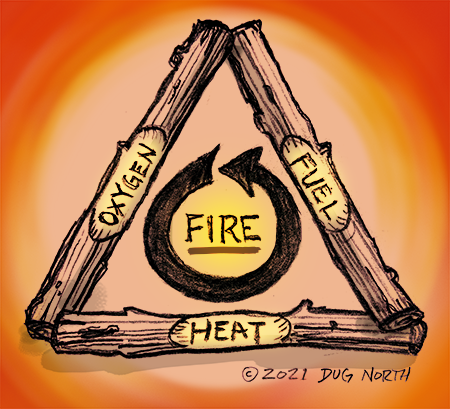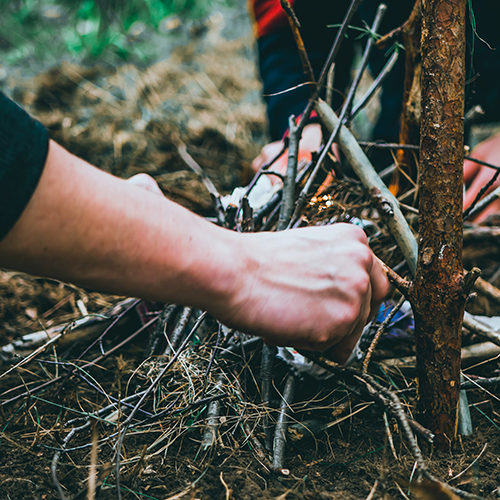An extra large ferrocerium rod with a custom fatwood handle
Why use an extra large ferro rod?
In preparation for an upcoming winter outing, I purchased an extra-large ferrocerium rod. My main ferro rod to date has been a 3/8” diameter rod that is 6 inches long. It has served me well. If the smaller rod works, why did I just buy such a large new one?
The need for a large ferro rod basically comes down to the desire to maximize my chance of success when starting a fire. More sparks from the ferro rod improve the chances of successfully igniting the tinder. The amount of sparks produced is largely a function of how much of the pyrophoric material is scraped from the ferro rod. This, in turn, is largely a function of how much of the rod’s surface is effectively scraped.
Compared to my old 6” rod, the new 8” rod increase the surface area of the ferro rod that is scraped by 33%. That’s a significant increase. What’s more, over time the diameter of the rod can contribute to an increase in surface area as well, if the rod is consistently used on one spot, thus creating a flat surface.
A fatwood handle for the ferro rod
I had an idea to add a fatwood handle to the new extra-long ferro rod. This would serve two purposes. First, the handle will help to keep my fingers out of the way so I can use more of the rod's length for creating sparks. Second, in the absence of suitable tinder in the environment, I can scrape fatwood shavings off the handle itself.
Schematic drawing showing how to add a wood handle to a large ferrocerium rod
What is fatwood and why is so great? First of all, fatwood doesn’t describe a particular species of tree. Rather, it is a general term that describes dried wood that has been naturally impregnated with flammable resin. Many resinous trees — mostly conifers — are capable of producing fatwood.
The resins in fatwood make it very flammable. Fine fatwood shavings scraped from a larger piece will readily accept the sparks from a ferro rod. They will even light when wet. Once lit, fatwood produces a strong flame that is able to resist gusts of wind and is capable of igniting larger pieces of fuelwood. Finally, fatwood is a material durable enough to serve as a sturdy handle.
Making and mounting a wood handle to the ferro rod
Mounting the fatwood to the ferrocerium rod was pretty straightforward. First, I used wood glue to bond two pieces of fatwood together to make a single piece thick enough to serve as the handle. Next, I used a drill press to drill a 1/2" diameter hole into one end of the fatwood. This is the same size as the diameter of the ferro rod. The ferro rod came with a small lanyard hole in one end. I measured where this hole would be located with the rod inserted into the fatwood, then drilled a small hole through the sides of the wood. I used a hammer to tap a piece of brass rod through both the handle and ferro rod. After trimming the rod flush with the sides of the handle, I peened (hammered) the ends of the brass rod to prevent it from sliding out. Alternatively, you could use a few drops of Super Glue to keep the pin from sliding out.
A modified leather knife sheath for carrying an extra large ferro rod on a belt
Creating a custom leather sheath for the ferro rod
This is a pretty large ferro rod, so I reasoned that it needed its own sheath. I had recently replaced an old leather knife sheath because the bottom seam had started to come apart. I cut the lower end completely off the sheath so the rod could poke through the bottom. Next, I soaked the old sheath in water for about 20 minutes, then fit the rod inside. I manipulated the wet leather to take the shape of the rod and handle. To ensure that the rod would never fall through the sheath, I added two metal rivets to the bottom of the sheath. Finally, I added a leather strap with a snap to keep the rod from ever falling out the top.
Using fatwood to create tinder
The process for using the fatwood handle to create tinder is the same method one would use for any piece of fatwood. The wood is scraped to produce fine shavings. This is often accomplished with the spine of a knife that has been ground to have a sharp 90-degree edge. Invert the rod such that you are using the rod as the handle and brace the fatwood on a stump or other suitable surface. Use the spine of a knife to scrape up and down on one of the exposed corners of the fatwood. Ideally, a golf ball-sized bundle would be made. I may use smaller bundles to extend the life of my handle. However, I don’t have to be conservative. Because glue wasn't used, I can replace the fatwood handle down the road if I wear it down from use.
RESOURCES
Kräftig 8″ Ferro Rod - this is where I got the one shown in this article
Leather Knife Sheath - this is the model of sheath I modified to hold the ferro rod in this article
* Some of the links on this page go to Amazon and some go to the website of my friend, Josh Enyart, The Gray Bearded Green Beret. I make a small commission on these referrals. I appreciate your support!










